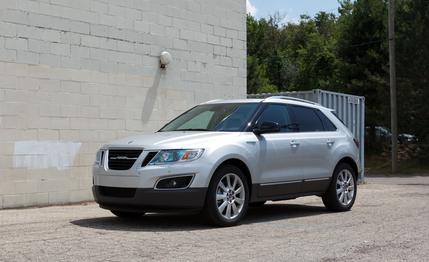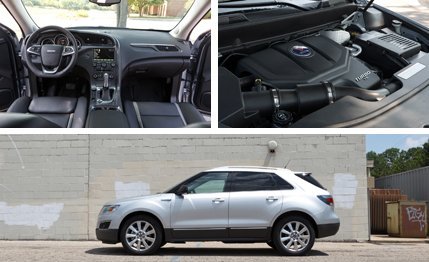
 Short Take Road Test
Short Take Road Test
What Is It?
It’s a Cadillac SRX crossover in Swedish clothing. The Saab 9-4X shares its platform, an assembly line, and most of its mechanicals with the Caddy. The top-dog Aero XWD, tested here, is powered by the 300-hp, 2.8-liter turbocharged V-6; a 265-horse, 3.0-liter V-6 is the base engine. Cadillac dropped both of these mills from the 2012 SRX lineup, introducing a 308-hp, 3.6-liter naturally aspirated V-6 for all trims. Good for Cadillac, bad for Saab: The turbo 2.8 and the 3.0 are deeply unsatisfying powerplants, and they make the 9-4X’s assigned task—delivering steady sales to a brand in desperate need of them—that much tougher.
How Does It Drive?
You might assume the 9-4X drives like an SRX, and you’d be correct, although not so fast. We mean that colloquially and literally, because, although the 9-4X behaves largely like the Caddy, it’s noticeably slower—more on that in a bit—and stiffer. In our first experience with the Saab, we noted a supple ride in the comfort and sport suspension settings, but the Saab felt overly firm on the roads surrounding our Michigan HQ. Things obviously got worse over the burliest broken pavement and loud, too, with suspension noises booming through the cabin. The stiffness makes for a flat attitude during cornering, but the trade-off isn’t really worth it in a luxury crossover. The same goes for the steering, which is excessively quick off-center; great in a track car, not so much here, where simple tracking corrections result in intralane ping-ponging.
The 2.8T exhibited the same surging and nonlinearity we experienced with this engine in the SRX, and it tugged the 9-4X to 60 mph in 7.7 seconds and through the quarter-mile in 16.0 seconds at 91 mph. Those numbers trail the 2.8T SRX’s—which weighed a scant 11 more pounds—by 0.5 second, 0.4 second, and 2 mph. The Saab’s stiffer suspenders couldn’t trump the Caddy on the skidpad, either, posting 0.82 g versus 0.84 (the two wore identical Michelin Latitude Tour HP rubber). Finally, the 9-4X’s brake pedal felt as hard and responsive as a cinder block, and the binders it actuated added 14 feet to the SRX’s 70-mph-to-0 figure, for a total of 187. At least we didn’t experience the same fireworks display in the IP during the braking test that we did with the Cadillac, which complained of overheating brakes.


How Does It Stack Up?
We’d put the 9-4X among the top tier in its segment—if the discussion were limited to styling. Favoring hard lines over the soft curves that characterize much of its competitive set (the ultra-creased SRX excluded, of course), the 9-4X looks great sitting still or in motion. And since it’s a Saab, it’s unlikely you’ll run into another one for weeks at a time, which ought to keep it looking fresh. But the comparison can stop right there. The interior has quality materials and soft surfaces, but its sea of black plastics is much too drab for the luxury set, and its Saab-esque touches—center-console-mounted start button, matrix vents, “night panel” function—aren’t quirky enough to save it. We do like the multifunction display in the gauge cluster, though, especially the altimeter-like redundant speed display. In terms of everything else, there are quicker, better-driving, higher-quality offerings from Acura, Audi, BMW, and Volvo, to name but a few.
What’s the Cost?
This top-level 9-4X Aero XWD starts at a substantial $48,835. That’s more than an Acura MDX with the Tech package, an Audi Q7 Premium Plus, a BMW X5 xDrive35i, or a Land Rover LR4 HSE, to say nothing of the excellent Audi Q5 or Volvo XC60. Our test vehicle rang the bell at $52,130, which included a $1450 panoramic sunroof and the $1845 Rear Passenger package, which nets a dual-screen DVD entertainment system, heated rear seats, and a trizone automatic climate-control system. A base front-wheel-drive 9-4X with the 3.0-liter V-6 begins at $34,205, which is a much more acceptable price for the crossover. But if it were our money, we’d hit the dealerships of any of the other aforementioned makers before looking here. That whole "savior of Saab" thing? The 9-4X could use some help of its own.